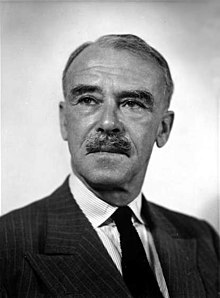Our website is made possible by displaying online advertisements to our visitors.
Please consider supporting us by disabling your ad blocker.
Richard Casey, Baron Casey
The Lord Casey | |
|---|---|
 Casey in 1954 | |
| 16th Governor-General of Australia | |
| In office 7 May 1965 – 30 April 1969 | |
| Monarch | Elizabeth II |
| Prime Minister | Sir Robert Menzies (1965–66) Harold Holt (1966–67) John McEwen (1967–68) John Gorton (1968–69) |
| Preceded by | The Viscount De L'Isle |
| Succeeded by | Sir Paul Hasluck |
| Minister for External Affairs | |
| In office 11 May 1951 – 4 February 1960 | |
| Prime Minister | Robert Menzies |
| Preceded by | Percy Spender |
| Succeeded by | Robert Menzies |
| Minister for External Territories | |
| In office 26 April 1951 – 11 May 1951 | |
| Prime Minister | Robert Menzies |
| Preceded by | Percy Spender |
| Succeeded by | Paul Hasluck |
| Minister in charge of the CSIRO | |
| In office 23 March 1950 – 4 February 1960 | |
| Prime Minister | Robert Menzies |
| Preceded by | Office established |
| Succeeded by | Donald Alastair Cameron |
| Minister for Works and Housing | |
| In office 19 December 1949 – 17 March 1950 | |
| Prime Minister | Robert Menzies |
| Preceded by | Nelson Lemmon |
| Succeeded by | Wilfrid Kent Hughes |
| Governor of Bengal | |
| In office 14 January 1944 – 19 February 1946 | |
| Preceded by | John Herbert |
| Succeeded by | Frederick Burrows |
| Minister to the United States of America | |
| In office 1 February 1940 – 20 April 1942 | |
| Prime Minister | Robert Menzies (1940–41) Arthur Fadden (1941) John Curtin (1941–42) |
| Preceded by | Office established |
| Succeeded by | Sir Owen Dixon |
| Treasurer of Australia | |
| In office 3 October 1935 – 26 April 1939 | |
| Prime Minister | Joseph Lyons (1935–39) Sir Earle Page (1939) |
| Preceded by | Joseph Lyons |
| Succeeded by | Robert Menzies |
| Member of the House of Lords Lord Temporal | |
| In office 16 May 1960 – 17 June 1976 | |
| Member of the Australian Parliament for La Trobe | |
| In office 10 December 1949 – 10 February 1960 | |
| Preceded by | Division created |
| Succeeded by | John Jess |
| Member of the Australian Parliament for Corio | |
| In office 19 December 1931 – 30 January 1940 | |
| Preceded by | Arthur Lewis |
| Succeeded by | John Dedman |
| Personal details | |
| Born | Richard Gavin Gardiner Casey 29 August 1890 Brisbane, Queensland, Australia |
| Died | 17 June 1976 (aged 85) Fitzroy, Victoria, Australia |
| Political party | United Australia (before 1945) Liberal (after 1945) |
| Spouse | |
| Alma mater | University of Melbourne Trinity College, Cambridge |
| Profession | Diplomat, politician |
| Military service | |
| Allegiance | Australia |
| Branch/service | Australian Imperial Force |
| Years of service | 1914–1919 |
| Rank | Major |
| Battles/wars | First World War |
| Awards | Distinguished Service Order Military Cross Mentioned in Despatches (2) |
Richard Gavin Gardiner Casey, Baron Casey (29 August 1890 – 17 June 1976) was an Australian statesman who served as the 16th governor-general of Australia, in office from 1965 to 1969. He was also a distinguished army officer, long-serving cabinet minister, Ambassador to the United States, member of Churchill's War Cabinet, and Governor of Bengal.
Casey was born in Brisbane, but moved to Melbourne when he was young. He entered residence at Trinity College, Melbourne, in 1909 while studying engineering at the University of Melbourne before continuing his studies at Trinity College, Cambridge. In 1914, Casey enlisted as a lieutenant in the Australian Imperial Force. He saw service in the Gallipoli Campaign and on the Western Front, reaching the rank of major and winning the Distinguished Service Order and the Military Cross before becoming a Chief Intelligence Officer in 1920. Casey joined the Australian public service in 1924 to work at Whitehall as a liaison officer with the British administration. He reported directly to the prime minister, Stanley Bruce, with whom he developed a close relationship.
In 1931, Casey was elected to federal parliament for the United Australia Party. He served as treasurer from 1935 to 1939 (under Joseph Lyons and Earle Page), and then as Minister for Supply and Development from 1939 to 1940 (under Robert Menzies). During the Second World War, Casey was Ambassador to the United States from 1940 to 1942, and then joined Winston Churchill's War Cabinet as its representative in the Middle East. In 1944, Churchill appointed him Governor of Bengal, where he handled the recovery from the 1943 famine and civil unrest in the lead-up to independence.
Casey returned to Australia in 1946. He was federal president of the fledgling Liberal Party from 1947 to 1950, and re-entered parliament at the 1949 election. Casey was reappointed to cabinet shortly after, again serving under Robert Menzies. He held various national development portfolios from 1949 to 1951, and then served as Minister for External Affairs until his retirement from politics in 1960. In 1965, Menzies named Casey to replace Lord De L'Isle as governor-general. He served for just under four years; the only major constitutional issue during his tenure was the disappearance of Harold Holt in 1967.
The City of Casey within Greater Melbourne is named in recognition of Casey.
Previous Page Next Page


